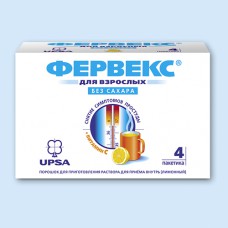Expiration date: 05/2026
Release form and composition:
Powder for the preparation of a solution for ingestion lemon light beige color, with a characteristic smell, brown inclusions are allowed.
1 pack:
paracetamol 500 mg
feniramina maleate 25 mg
ascorbic acid 200 mg
Excipients: mannitol, citric acid anhydrous, povidone, trimagnia dicitrate anhydrous, aspartame, lemon-rum flavor (Anties).
4.95 g-bags from the combined material (6) - packs cardboard.
4.95 g-bags from the combined material (8) - packs cardboard.
4.95 g-bags from the combined material (12) - packs cardboard.
4.95 g-bags from the combined material (16) - packs cardboard.
Powder for preparation of solution for the reception inside the lemon with sugar is a light beige color with a characteristic smell allowed blotches of brown color.
1 pack:
paracetamol 500 mg
feniramina maleate 25 mg
ascorbic acid 200 mg
Excipients: sucrose, anhydrous citric acid, Arabian gum, soluble saccharin, lemon-rum flavoring (Anties).
13.1 g-bags from the combined material (6) - packs cardboard.
13.1 g-bags from the combined material (8) - packs cardboard.
Powder for the preparation of a solution for oral administration raspberry with sugar from light pink to light beige color, inclusions of dark pink color are allowed.
1 pack:
paracetamol 500 mg
feniramina maleate 25 mg
ascorbic acid 200 mg
Excipients: sucrose, citric acid anhydrous, Arabian gum, sodium saccharinate, raspberry flavor.
12.75 g-bags from the combined material (4) - packs cardboard.
12.75 g-bags from the combined material (5) - packs cardboard.
12.75 g-bags from the combined material (6) - packs cardboard.
12.75 g-bags from the combined material (8) - packs cardboard.
Pharmacological action:
Combined drug for symptomatic therapy of acute respiratory infections.
Paracetamol-analgesic-antipyretic, has analgesic and antipyretic effect, which is due to its effect on the center of thermoregulation in the hypothalamus eliminates headaches and other types of pain, reduces fever.
Ascorbic acid (vitamin C) is involved in the regulation of redox processes, carbohydrate metabolism, blood clotting, tissue regeneration, in the synthesis of GCS, collagen and procollagen normalizes capillary permeability. Increases the body's resistance, which is associated with the stimulation of the immune system.
Feniramin - blocker of histamine H1-receptors, reduces rhinorrhea, feeling of nasal congestion, sneezing, lacrimation, itching and redness of the eyes.
Pharmacokinetics:
Data on the pharmacokinetics of the drug Fervex are not provided.
Indications:
- SARS (symptomatic therapy)
- rhinopharyngitis.
Dosage regimen:
Fervex is prescribed inside 1 sachet 2-3 times/day. preferably between meals. The interval between doses of the drug is at least 4 hours.
In patients with impaired liver or kidney function and elderly patients, the interval between doses of the drug should be at least 8 hours.
The duration of treatment (without consulting a doctor) is not more than 5 days when used as an analgesic and not more than 3 days - as an antipyretic.
The drug should be completely dissolved in a glass of warm water and the resulting solution immediately drink.
Side effect:
From the digestive system: nausea, pain in the epigastric region rarely-dry mouth with prolonged use in doses significantly higher than recommended, increases the likelihood of liver dysfunction.
From the hematopoietic system: rarely-anemia, thrombocytopenia, methemoglobinemia.
On the part of the urinary system: rarely-urinary retention with prolonged use in doses significantly higher than recommended, increases the likelihood of renal dysfunction.
Allergic reactions: skin rash, itching, urticaria, Quincke's edema.
Other: rare - paresis of accommodation, drowsiness.
The drug is well tolerated in the recommended doses.
Contraindications:
- erosive and ulcerative lesions of the gastrointestinal tract (in the acute phase)
- renal failure
- portal hypertension
- chronic alcoholism
- deficiency of glucose-6-phosphate dehydrogenase
- children under 15 years of age
- I and III trimesters of pregnancy
- lactation (breastfeeding)
- hypersensitivity to the components of the drug.
With caution, the drug should be used in hepatic insufficiency, angle-closure glaucoma, prostatic hyperplasia, congenital hyperbilirubinemia (Gilbert, Dubin-Johnson and Rotor syndromes), viral hepatitis, alcoholic hepatitis, in elderly patients.
Pregnancy and lactation:
Contraindicated use of the drug in the I and III trimesters of pregnancy and lactation (breastfeeding).
Special instruction:
If it is necessary to take metoclopramide, domperidone or colestyramine during the use of Fervex, the patient should consult a doctor.
During the application of Ferveks possible distortion of laboratory studies in the quantitative determination of the concentration of uric acid and glucose in plasma.
In order to avoid toxic liver damage, paracetamol should not be combined with alcohol intake, as well as taken by persons prone to chronic alcohol consumption.
When using the drug, the risk of liver damage increases in patients with alcoholic hepatosis.
With long-term use in doses significantly higher than recommended, it is necessary to monitor the peripheral blood picture.
Use in patients with diabetes
The drug in the form of a powder for the preparation of a solution for ingestion of lemon does not contain sugar and can be used in patients with diabetes mellitus.
In 1 sachet of the drug in the form of a powder for the preparation of a solution for ingestion of lemon with sugar or raspberry with sugar contains 11.5 g of sugar, which corresponds to 0.9 HE. This should be taken into account when it is necessary to use this dosage form in patients with diabetes mellitus or in patients on a diet with a low sugar content.
Overdose:
Symptoms are due to the action of paracetamol: pallor of the skin, decreased appetite, nausea, vomiting hepatonecrosis (the severity of necrosis due to intoxication directly depends on the degree of overdose). Toxic effect in adults is possible after taking paracetamol at a dose of more than 10-15 g: increased activity of hepatic transaminases, increased prothrombin time (12-48 hours after administration) the detailed clinical picture of liver damage is manifested in 1-6 days. Rarely-lightning development of liver failure, which can be complicated by renal failure (tubular necrosis).
Treatment: in the first 6 h after overdose-gastric lavage, the introduction of sh-group donators and precursors of glutathione - methionine synthesis through 8-9 h after overdose and N-acetylcysteine through 12 h. the Need for additional therapeutic measures (further introduction of methionine, intravenous administration of N-acetylcysteine) is determined by the concentration of paracetamol in the blood, as well as the time elapsed after
Drug interaction:
Antidepressants, antiparkinsonian agents, antipsychotic agents (phenothiazine derivatives) - increase the risk of side effects (urinary retention, dry mouth, constipation) of Fervex.
When used concurrently with Fervex, GCS increases the risk of glaucoma.
Inducers of microsomal oxidation in the liver (phenytoin, ethanol, barbiturates, rifampicin, phenylbutazone, tricyclic antidepressants) increase the production of hydroxylated active metabolites of paracetamol, which makes it possible to develop severe intoxication with a small overdose of the drug.
Inhibitors of microsomal oxidation (including cimetidine) reduce the risk of hepatotoxic effects of paracetamol.
Paracetamol reduces the effectiveness of uricosuric drugs.
Ethanol contributes to the development of acute pancreatitis.
Ethanol enhances the sedative effect of antihistamines.
Storage terms and conditions:
The drug should be stored out of reach of children, dry place at a temperature not higher than 25°C. shelf Life-3 years.








